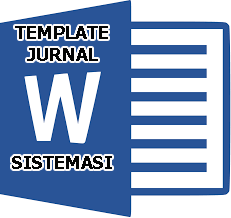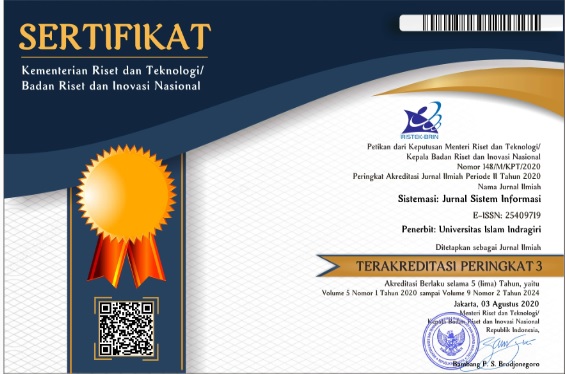User Behavior Analysis of E-Wallet Usage Among Generation Z using the Theory of Planned Behavior
Abstract
Keywords
Full Text:
PDFReferences
R. I. Permana, “Analisis Faktor Penggunaan Dompet Digital di Kalangan Mahasiswa Perguruan Tinggi Surabaya,” JATISI (Jurnal Tek. Inform. dan Sist. Informasi), Vol. 8, no. 1, pp. 312–322, Mar. 2021. https://doi.org/10.35957/jatisi.v8i1.584
S. Singh, M. M. Sahni, and R. K. Kovid, “What Drives Fintech Adoption? A Multi-Method Evaluation using an Adapted Technology Acceptance Model,” Manag. Decis., Vol. 58, No. 8, pp. 1675–1697, 2020. https://doi.org/10.1108/MD-09-2019-1318
H. M. Aji, I. Berakon, and M. Md Husin, “COVID-19 and E - Wallet Usage Intention: A Multigroup Analysis between Indonesia and Malaysia,” Cogent Bus. Manag., Vol. 7, No. 1, 2020. https://doi.org/10.1080/23311975.2020.1804181
A. Shankar, B. Datta, C. Jebarajakirthy, and S. Mukherjee, “Exploring Mobile Banking Service Quality: A Qualitative Approach,” Serv. Mark. Q., Vol. 41, No. 2, pp. 182–204, 2020. https://doi.org/10.1080/15332969.2020.1742982
N. Singh and N. Sinha, “How Perceived Trust Mediates Merchant’s Intention to use a Mobile Wallet Technology,” J. Retail. Consum. Serv., Vol. 52, No. March 2019, p. 101894, 2020. https://doi.org/10.1016/j.jretconser.2019.101894
L. S. Arum, A. Zahrani, and N. A. Duha, “Karakteristik Gen Z dan Kesiapannya dalam menghadapi Bonus Demografi 2030,” Account. Student Res. J., Vol. 2, No. 1, pp. 59–72, 2023. https://doi.org/10.62108/asrj.v2i1.5812
Y. Yennisa and H. R. N. Putri, “Faktor-Faktor yang Berpengaruh pada Keputusan Penggunaan E - Wallet dalam Transaksi Pembayaran (Studi di Pasar Tradisional Daerah Istimewa Yogyakarta),” UPY Bus. Manag. J., Vol. 2, No. 2, pp. 30–39, Jul. 2023. https://doi.org/10.31316/ubmj.v2i2.5075
N. Maharani and W. Meiranto, “Analisis Faktor-Faktor yang memengaruhi Niat Perilaku Penggunaan E - Wallet terhadap Perilaku Pengguna dengan menggunakan Model Unified Theory Of Acceptance And Use Of Technology 3 (UTAUT 3) pada Mahasiswa di Kota Semarang,” DIPONEGORO J. Account., Vol. 13, No. 4, pp. 1–15, 2024.
N. M. Sutoyo and Qammaddin, “Penerapan Metode Theory Of Planned Behavior ( TPB ) dan Technology Acceptance Model ( TAM ) pada Pengguna,” Justek J. Sains Dan Teknol., Vol. 6, No. 3, pp. 345–355, 2023. https://doi.org/10.31764/justek.v6i3.17160
S. Intan, M. Fronita, M. L. Hamzah, E. Saputra, Anofrizen, S. Siregar, “Analisis Perilaku Pengguna SAMSAT Digital Nasional menggunakan Metode TAM danTPB,” Vol. 7, No. 4, pp. 1472–1483, 2024. https://doi.org/10.32493/jtsi.v7i4.44362
R. D. Aviyanti, “Perilaku Pengguna E-accounting berdasarkan Perspektif Combined-TAM-TPB (C-TAM-TPB),” Fisc. J. Akunt. dan Perpajak., Vol. 2, No. 1, p. 12, 2024. https://doi.org/10.25273/jap.v2i1.19304
U. C. Whidya, “Attitide, Subjective Norms, Perceived Behavior, Entrepreneurship Education and Self-efficacy toward Entrepreneurial Intention University Student in Indonesia,” Eur. Res. Stud. J., Vol. 20, pp. 475–495, 2017.
P. a Pavlou and M. Fygenson, “Understanding and Predicting Electronic Commerce Adoption : An Extension of the Theory of Planned Behavior Qjarteny and Predicting Understanding Electronic an Extension of Commerce Adoption : the Theory of Planned formed,” Underst. Predict. Electron. Commer. Adopt. An Ext. Theory Plan. Behav., Vol. 30, No. 1, pp. 115–143, 2006. https://doi.org/10.2307/25148720
V. Venkatesh and F. D. Davis, “A Model of the Antecedents of Perceived Ease of use: Development and Test,” Decis. SCI., Vol. 27, No. 3, pp. 451–481, 1996. https://doi.org/10.1111/j.1540-5915.1996.tb00860.x
R. B. H. Siagian, Z. J. H. Tarigan, S. R. Basana, “The Effect of Perceived Security, Perceived Ease of use, and Perceived Usefulness on Consumer Behavioral Intention Through Trust in Digital Payment Platform,” Int. J. Data Netw. Sci., Vol. 6, p. 120, 2022.
N. Kamariah, N. Mat, and I. Sentosa, “The Integration of Theory of Planned Behaviour (TPB) and Technology Acceptance Model in Internet Purchasing: A Structural Equation Modelling (SEM) Apparoach,” Proc. Appl. Int. Bus. Conf., No. April, 2008.
J. F. Hair, J. J. Risher, M. Sarstedt, and C. M. Ringle, “The Results of PLS-SEM Article Information,” Eur. Bus. Rev., Vol. 31, No. 1, pp. 2–24, 2019.
D. H. Perkasa and H. Mulyanto, “Pengaruh Beban Kerja, Gaya Kepemimpinan dan Kedisplinan terhadap Kinerja Guru,” Revenue Lentera Bisnis Manaj., Vol. 1, No. 04, pp. 149–161, 2023.
H. Halin, H. Wijaya, and R. Yusilpi, “Pengaruh Harga Jual Kaca Patri Jenis Silver terhadap Nilai Penjualan pada CV. Karunia Kaca Palembang Tahun 2004-2015,” J. Ecoment Glob., Vol. 2, No. 2, pp. 49–56, 2017.
J. F. Hair, G. T. M. Hult, C. M. Ringle, M. Sarstedt, N. P. Danks, and S. Ray, Partial Least Squares Structural Equation Modeling (PLS-SEM) Using R. Cham: Springer International Publishing, 2021.
DOI: https://doi.org/10.32520/stmsi.v14i4.5312
Article Metrics
Abstract view : 787 timesPDF - 185 times
Refbacks
- There are currently no refbacks.

This work is licensed under a Creative Commons Attribution-ShareAlike 4.0 International License.









